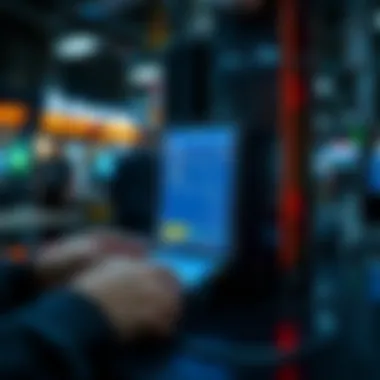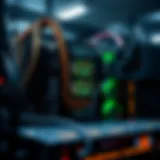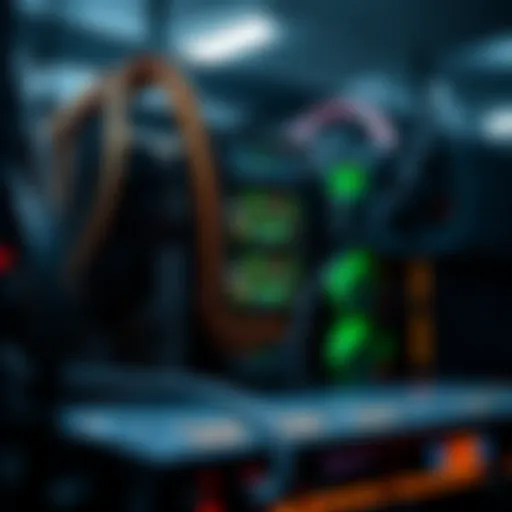Top Marketplaces for Buying NFTs: A Comprehensive Guide


Intro
In the ever-evolving world of digital assets, non-fungible tokens (NFTs) have carved out their niche, piquing interest across diverse demographics – from seasoned investors to curious newcomers. As the digital art revolution unfolds and collectibles find new formats, it’s essential to navigate the landscape of platforms where these unique tokens can be acquired.
Buyers seeking to invest in NFTs face an array of choices. Each marketplace boasts its own systems, user interface, and community dynamics. Without proper guidance, one may find themselves mired in confusion, struggling to make informed choices. This discussion aims to spotlight those platforms worth your time, detailing their unique features, advantages, and the user experiences they offer.
Crypto Concepts Explained
Before diving into specific platforms, it's important to grasp the underlying technology and terms that shape the NFT ecosystem.
Key Terminology and Definitions
Understanding NFT jargon can seem daunting at first. Here are some fundamental terms:
- Blockchain: A decentralized ledger that securely records transactions across multiple computers.
- Smart Contracts: Self-executing contracts with the terms of agreement directly written into code, often used for NFT transactions.
- Minting: The process of creating a digital asset on a blockchain.
- Gas Fees: The costs associated with processing transactions on a blockchain. These fees can vary widely based on network traffic.
Having a firm grasp on these terms can clarify discussions and decisions within this arena.
Practical Applications of Blockchain Technology
The practical use of blockchain technology extends beyond mere transactions. In the NFT realm, it guarantees provenance, authenticity, and ownership without the need for traditional intermediaries. Digital artists can sell their work directly to buyers, keeping a larger share of the profits. Furthermore, programmable royalties can be embedded within smart contracts, allowing creators to earn a percentage from future resales of their work, fostering a sustainable ecosystem.
"The promise of blockchain lies in its ability to transcend geographical boundaries, democratizing access to art, music, and collectibles."
Exploring the capabilities of these technologies provides insight into what makes NFTs appealing, as both investment vehicles and tools for creative expression.
Navigating through those concepts will lead us to discuss platforms and how the intersection of community, technology, and user experience plays a significant role in the purchasing process.
Understanding NFTs
In order to navigate the ever-expanding landscape of digital assets, grasping the essence of Non-Fungible Tokens (NFTs) is pivotal. These unique tokens represent ownership or proof of authenticity of a digital item, be it art, music, or virtual real estate. Unlike their fungible counterparts like cryptocurrencies, which are interchangeable, NFTs are distinct and contain unique identifiers. This distinction not only adds value but also opens doors for various applications across diverse industries.
By comprehending the fundamental characteristics and evolution of NFTs, investors, developers, and enthusiasts can make more informed decisions when acquiring these digital assets. Furthermore, understanding the implications of NFTs can lead to innovative uses in art, gaming, and more, positioning stakeholders at the forefront of this digital revolution.
Definition and Characteristics
Non-fungible tokens are digital assets verified using blockchain technology, primarily the Ethereum blockchain, that certify the ownership and uniqueness of a specific item or piece of content. Unlike dollars or Bitcoin, which can be exchanged on a one-to-one basis, each NFT holds distinct information that makes it irreplaceable. This uniqueness can stem from the token’s metadata, which contains details like creator information and transaction history.
Some core characteristics include:
- Indivisibility: NFTs cannot be divided into smaller units; they exist as whole items.
- Ownership Verification: The ownership of NFTs is tracked through the blockchain, offering clear and secure records.
- Creator Rights: Artists and creators can embed royalties, ensuring they receive a percentage of resale values.
"NFTs revolutionize the way ownership and provenance of digital goods are established."
The Evolution of NFTs
Initially, NFTs began gaining traction with projects like Cryptokitties in 2017, which allowed users to buy, breed, and sell virtual cats. Since then, the NFT landscape has exploded into a multi-billion-dollar market, attracting artists, musicians, and brands. The transition from simple collectibles to high-art markets has been profound. Platforms like SuperRare and Foundation have created spaces where digital artists can sell their works directly to collectors.
Additionally, the introduction of various standards like ERC-721 and ERC-1155 has improved the functionality of NFTs, enabling features such as multiple copies of a single item while retaining uniqueness. This progress highlights the rapid innovation in the NFT space and points toward a future where NFTs become integrated into everyday transactions.
Use Cases Across Various Industries
The versatility of NFTs has led to their adoption across numerous industries, indicating their potential beyond digital art. Notably, the following use cases stand out:
- Art and Collectibles: Digital artists sell unique pieces, and collectors own them as verified assets.
- Gaming: Players can own in-game items, trade them, or even earn through play-to-earn models, fundamentally changing how games are monetized.
- Virtual Real Estate: Platforms like Decentraland allow users to buy, sell, and develop virtual spaces.
- Music: Musicians are releasing tracks as NFTs, allowing for direct engagement with fans and alternative revenue streams.
Criteria for Selecting NFT Marketplaces
Navigating the NFT landscape can feel like wandering through a maze without a map. With the plethora of marketplaces sprouting, how does one choose the right one? The answer lies in understanding the criteria that truly matter before diving into this exciting but complex world of non-fungible tokens. Selecting an NFT marketplace involves more than just picking a recognized name; it means considering the totality of your transaction, from security to user experience. Each of these factors plays a critical role in ensuring your foray into NFTs is safe, smooth, and ultimately rewarding.
Security Measures
When engaging in any form of digital transaction, security is king. In the context of NFTs, where assets can cost thousands, if not millions, of dollars, it becomes even more crucial. A solid NFT marketplace will possess robust security protocols—two-factor authentication, to encryption and cold storage options.
Many reputable platforms like Opensea utilize a comprehensive security framework, ensuring users' wallets and data are well protected. While no system is infallible, choosing a marketplace with a proven security track record is the first line of defense against potential threats. Think of it as a shield; a good shield can mean the difference between protecting your investments or losing everything in an unfortunate breach.


Transaction Fees and Charges
What's a marketplace without its pricing structure? Transaction fees can vary widely from one platform to another, and understanding these costs is essential for budgeting purposes. Some platforms have a flat fee, while others might operate on a tiered basis depending on the asset value.
For instance, Rarible charges a percentage-based fee, but users can also earn through governance token rewards. Being transparent about fees not only helps you plan, but also sheds light on the marketplace's business model. If a platform is too expensive after taxes and fees are included, you might as well look for a more cost-efficient option.
User Interface and Experience
User experience (UX) can truly make or break your NFT purchasing journey. An intuitive and straightforward interface can ease newcomers into this often-complex space. Imagine wading through a clunky site with hidden fees, confusing menus, and unclear terms of service. It sounds like a nightmare, right? Conversely, many platforms prioritize clean design and smooth navigation, ensuring users feel comfortable as they browse and purchase.
For example, platforms like Mintable provide user-friendly environments perfect for beginners. The engagement isn’t just about aesthetics; it’s about how quickly and easily a buyer can find, learn about, and purchase an asset. A well-designed interface helps demystify the process, making it less daunting for anyone who’s sorting through their first digital assets.
Community and Support
A marketplace isn’t just a transaction hub; it's also a community. The interaction between users can lead to valuable insights and information sharing. Consider platforms with active forums or customer support teams. Having a responsive support system makes a huge difference. If a problem arises after a purchase, efficient support can be the safety net that saves you from long-term headaches.
Many marketplaces feature community-driven governance or feedback systems to incorporate user opinions into platform development. For instance, communities on Reddit or Discord channels often discuss their experiences, providing fledgling investors with the wisdom of those who’ve already navigated the waters.
"In the world of NFTs, knowledge truly is power. Engaging with community channels can assist in making informed decisions."
These criteria not only facilitate a seamless user experience but also contribute to building trust and engagement within the NFT ecosystem. Understanding and analyzing these aspects can guide your choices effectively, leading to wiser investment decisions. As the NFT space evolves, continually examining these factors will be valuable as one seeks the most suitable marketplace for their needs.
Established NFT Marketplaces
The emergence and popularity of non-fungible tokens has set the stage for various platforms, each carving out its own niche in the market. Established NFT marketplaces play a significant role in this evolving landscape, acting as both the conduit for artists and collectors, and providing a framework for trading these unique digital assets. The importance of these platforms lies in their stability, user base, and a myriad of features that cater to different audiences. They offer not just access to NFTs, but also robust ecosystems that include community engagement, support for creators, and mechanisms for fostering trust among users.
OpenSea: The Market Leader
Features and Benefits
OpenSea stands tall as the frontrunner in the NFT marketplace realm, providing a multitude of features that cater to varying user needs. Its extensive variety of digital assets ensures that visitors can discover everything from artwork to virtual real estate. The user-friendly interface simplifies the browsing and purchasing processes, enabling enthusiasts to dive right into NFT trading without unnecessary complexity. One notable aspect is the support for several blockchain networks, including Ethereum and Polygon, offering flexibility in transactions.
This vast selection translates into a rich pool of opportunities for buyers and sellers alike, making it a popular choice for those looking to establish their presence in the NFT space. OpenSea is particularly beneficial for new users, as it offers tutorials and a wide range of resources aimed at educating potential buyers on NFT fundamentals and usage.
Drawbacks and Considerations
However, nothing is perfect. OpenSea does have its drawbacks. One of the primary concerns is the issue of high gas fees associated with transactions on the Ethereum network, which can deter potential buyers who are on a budget. Furthermore, as a marketplace with a large user base, there is a risk of facing counterfeit items, which can dim the confidence of collectors. While the intuitive design is a plus, some features might be overwhelming for newcomers.
It's also worth noting that the diversity of products available can sometimes make it harder for users to find what they specifically are looking for amidst the myriad of listings. For those who prefer a more curated experience, the vastness of OpenSea can be both a blessing and a curse.
Rarible: The Platform for Creators
Decentralized Governance
Rarible distinguishes itself with its commitment to decentralization. Through a community-driven governance model, users can propose and vote on platform decisions, giving them a genuine stake in the marketplace's development. This aspect resonates with many creators who value a sense of ownership over their engagement in the NFT ecosystem. Such decentralized governance establishes a stronger emotional connection between creators and the platform while fostering innovation.
Empowering users in this way adds to the overall appeal of Rarible for creators who often seek platforms that uphold their interests. By implementing community feedback into platform enhancements, Rarible shows that it listens to its user base, making it an appealing option for those in search of a more collaborative environment.
Incentives for Users
Additionally, Rarible incorporates a range of incentives aimed at enhancing user interaction and engagement. The introduction of RARI tokens allows users to earn rewards and engage in governance decisions, aligning their interests with the marketplace’s growth. This model helps build a loyal user base, as creators feel they are part of a community driven by mutual benefits rather than just transactional relationships.
However, while the token rewards are enticing, they also bring an element of volatility to the platform. This might deter some users who prefer an experience free from potential risks associated with fluctuating token values.
Foundation: Curation and Exclusivity
Curator Involvement
Foundation’s emphasis on curation sets it apart from more crowded marketplaces. By handpicking artists and artworks, Foundation cultivates an exclusive atmosphere, appealing particularly to collectors who appreciate high-quality art. The involvement of curators not only elevates the quality of available NFTs but also ensures that each piece has a story and background worth exploring.
This curated approach makes it more than a trading venue; it’s a space where art is appreciated and respected. The exclusivity brought about by invitations for creators can also lead to a sense of community among artists, as they often find themselves part of a distinguished group.
Artist Support
In terms of artist support, Foundation takes significant steps to empower creators. The platform encourages collaboration and provides resources for artists to grow, which is essential in an ecosystem that can be so competitive. This support can help lesser-known artists gain visibility without getting overshadowed by more prominent names.
Despite these advantages, the platform does have its limitations; the exclusivity might alienate some creators who feel they do not have the same opportunity as others. Such a model easily leads to debates about accessibility and equality within the NFT community.


SuperRare: A Focus on High-Quality Art
Unique Selling Points
SuperRare focuses on not just selling art, but on showcasing it in a gallery-like experience. Each artwork is carefully vetted, leading to a distinct collection of high-quality pieces that appeal to serious collectors. This curated approach to NFTs means that collectors can trust the quality of what they purchase, which is a significant factor when investing in digital art.
With SuperRare, the focus on the artist's narrative adds significant value to the NFTs, which can elevate the perceived worth of a piece. Furthermore, the platform emphasizes its community, fostering connections between collectors and artists, which can enhance the ownership experience.
Artist Vetting Process
The artist vetting process is another cornerstone of SuperRare's appeal. By ensuring that only select artists can list their work, SuperRare not only maintains a high standard but also encourages artists to put genuine effort into their projects. This vetting fosters trust among collectors, as they can rest assured that they are acquiring pieces from reputable creators.
However, this rigorous selection process can also be a double-edged sword, as emerging artists may find it challenging to gain entry into the marketplace. This could potentially lead to a perception of elitism, which could misalign with the original decentralizing intentions of the NFT movement.
Overall, while the established marketplaces provide robust platforms for buying and selling NFTs, each offers distinct advantages and challenges. Understanding these can help potential investors, developers, and creators navigate the NFT landscape more effectively.
Emerging NFT Marketplaces
The realm of NFTs is bustling with innovation, making Emerging NFT Marketplaces a hot topic. These platforms hold significant promise not just for collectors but also for artists, developers, and enthusiasts at large. Unlike established marketplaces, emerging platforms often prioritize user experience and community involvement, reflecting a grassroots approach in the NFT ecosystem. By exploring these newer options, users can uncover unique opportunities that established giants may not present.
Mintable: User-Friendly for Beginners
Creating NFTs with Ease
Creating non-fungible tokens should not feel like rocket science, and that’s where Mintable shines. The platform simplifies the process into a step-by-step guide, even for those who may not have a tech-savvy background. Users can create NFTs from images or files without needing to touch a single line of code. This accessibility fosters creativity among budding artists looking to enter the NFT market. One notable feature is the smart contract generator that automatically sets everything for the users. While ease of use is a clear advantage, it's essential to acknowledge that this simplicity might limit certain customization options that more experienced creators crave.
Market Features
Mintable is not just a walk in the park for newcomers; it’s also packed with market features catering to various user needs. Users can browse a vast gallery of NFTs, participate in auctions, and even set fixed prices for their creations. The marketplace's intuitive layout makes it easy to navigate, enhancing the overall buying and selling experience. Additionally, the platform features a robust search functionality, allowing users to find specific types of NFTs quickly. However, it’s worth noting that some advanced features available on competing platforms may be absent, potentially limiting more seasoned users.
Zora: Empowering Creators and Communities
Community-Centric Features
Zora stands apart with its emphasis on community engagement and creator empowerment. By prioritizing direct interactions between artists and their audiences, it offers features like curated collections and community voting on NFT launches. This creates a space where the community has a direct say in the types of artworks being sold. The platform not only supports artists but also encourages collaborations among creators. One downside could be that less established creators might find it challenging to gain visibility in a competitive environment.
Token Economics
Zora introduces an innovative approach to token economics that benefits creators and their communities. Tokens are used for a variety of activities, including governance, enabling members to vote on upcoming features or changes on the platform. This decentralized model adds to a sense of ownership among users and can cultivate loyalty in a market where that’s crucial. Nonetheless, the economic model is also quite complex, which can be a hurdle for users who are looking for a straightforward buying experience.
Nifty Gateway: Limited Edition Drops
Exclusive Collaborations
Nifty Gateway sets itself apart by offering limited edition drops that feature collaborations with well-known artists and brands. This exclusivity creates a buzz and draws significant attention whenever a new drop is announced. The hype surrounding these releases can lead to successful reselling opportunities on secondary markets, appealing to investors. A potential downside is that newcomers may feel overwhelmed during drops due to high traffic, which could affect their chances of purchasing desired NFTs.
Accessibility
Another fascinating aspect of Nifty Gateway is its approach to accessibility. The platform allows purchases with credit cards, making it easier for those unfamiliar with cryptocurrencies to participate without requiring significant initial investments. This lowers the entry barrier considerably, allowing a broader audience to engage with NFTs. However, it does come with a catch; the reliance on fiat currency could be a limitation for users who are looking for a fully decentralized transaction experience.
Emerging NFT marketplaces like Mintable, Zora, and Nifty Gateway are crucial for broadening the NFT landscape. They cater to diverse needs that established platforms may not address, thereby fueling innovation and inclusivity in the space.
By understanding these emerging players in the NFT marketplace, investors, analysts, developers, and enthusiasts can navigate their options more strategically, leading to sound decisions in an otherwise crowded market.
Navigating the Buying Process
Understanding how to navigate the buying process of NFTs is crucial for anyone looking to delve into this vibrant marketplace. Just as one wouldn't traverse the wilderness without a map, entering the NFT space without knowledge of the buying process can lead to pitfalls. This section addresses the essential components that make up the journey of acquiring NFTs, from taking the first step in setting up a digital wallet to the nuances of bidding and purchasing.
Setting Up a Digital Wallet
Before a potential buyer can even think about purchasing an NFT, the most fundamental requirement is having a digital wallet. This wallet serves not only as a storage solution for your cryptocurrencies but also as a gateway to accessing various NFT marketplaces. The process is akin to finding a safe place to store valuable items – without it, all your other endeavors might be in vain.
To set up a digital wallet, you first need to decide on the type you prefer. Hot wallets are connected to the internet and often easier to use, while cold wallets offer enhanced security by not being connected online. Some popular hot wallet options include MetaMask and Trust Wallet, which allow seamless interaction with decentralized applications. Alternatively, if security is your primary concern, hardware wallets like Ledger or Trezor might suit you better, albeit with a more complex setup process.
Installing a wallet involves downloading the application (or acquiring a device), creating an account, and safeguarding your recovery phrase- essentially a set of secret words that grant access to your funds. Once your wallet is set up, you’ll be ready to deposit some cryptocurrency.
Choosing Compatible Cryptocurrencies


Having a digital wallet is just the start. Not all NFTs can be bought with every cryptocurrency, so selecting the right digital currency is essential. The most common form of payment for NFTs is Ethereum (ETH), as many marketplaces predominantly operate on this blockchain. A knowledgeable buyer should familiarize themselves with other options as well, such as Flow or Polygon, which may have unique benefits depending on the platform.
When purchasing cryptocurrencies, platforms like Coinbase or Binance allow users to convert traditional money into digital currency with relative ease. However, before grabbing the first cryptocurrency you see, it's vital to dive deeper into the purpose of each token and its utility on various platforms. Read up on exchange rates and transfer fees as they can vary widely, impacting the overall cost to the buyer.
Bidding and Purchase Mechanisms
Finally, when you’ve got your wallet filled with the right cryptocurrency, it’s time to engage with the marketplace itself. Most NFT platforms utilize different bidding and purchasing mechanisms, and understanding these can significantly influence your buying success.
For instance, some platforms operate through fixed-price listings where you can buy NFTs at listed prices. In contrast, others function on an auction basis, where prospective buyers can place bids. Familiarizing yourself with the mechanics of each platform is essential.
- Fixed Price Listings: Simply click “buy” to make the purchase.
- Auction Bidding: You'll need to keep an eye on the auction timer and potentially outbid others.
Each method serves its purpose, and sometimes, luck can be as important as strategy.
"The NFT marketplace can feel like a wild west, but understanding the buying process is your trusty steed that will lead you to success."
In closing, navigating the buying process is about preparation, understanding, and agility in making informed decisions. The NFT landscape can be treacherous at times, but with a clear grasp of these fundamental aspects, you can embark on your NFT collection journey with confidence.
Post-Purchase Considerations
After completing a purchase in the fast-paced NFT market, it’s crucial to grasp the implications of your acquisition. Understanding the nuances of ownership, reselling, and preservation can ensure that your investment remains protected and potentially profitable in the long run. Each aspect plays a significant role in how one interacts with their digital assets, impacting everything from future trading opportunities to the longevity of the NFT itself.
Understanding Ownership and Rights
NFTs, while revolutionary, come with complexities regarding ownership. When you buy an NFT, you typically do not acquire the copyright to the digital asset unless explicitly stated. Instead, what you gain is the ownership of a unique token stored on a blockchain that signifies your claim. This token can demonstrate authenticity and provenance, but there could be restrictions on how the associated digital item is used.
Here are some pointers to consider:
- Licensing Terms: Always check the licensing terms associated with your NFT. Some creators allow you to use their work under certain conditions, while others may impose strict limitations.
- Copyright Issues: Be aware of copyright laws that govern digital works. Owning an NFT doesn’t automatically grant you copyright; in many cases, you may need to secure that separately.
- Potential for Rights Transfer: Certain marketplaces or individual creators may offer terms that allow rights to transfer with the sale of the NFT, which can significantly enhance its value.
"Ownership of an NFT is more about the token's signature on the blockchain than the underlying asset itself."
Reselling and Trading NFTs
The resale market for NFTs is bustling. Yet, entering the trade requires a solid understanding of market dynamics. NFTs can appreciate in value due to demand, community hype, or even the creator’s future engagements. However, reselling isn’t as straightforward as flipping a house. Here are several factors to consider:
- Market Fluctuations: Just like stocks or cryptocurrencies, the value of NFTs can swing wildly. Keep an eye on trends, but don’t chase every rise or fall.
- Platform Fees: Each marketplace has its fee structure for reselling. OpenSea, for instance, has specific fees that sellers should consider before listing an NFT.
- Reputation Matters: A well-respected creator or collection may sell more easily than lesser-known entities. Community perception can drastically affect an NFT's marketability.
- Timing Your Sale: When you choose to sell can be critical. Striking while the iron is hot can yield better returns than waiting.
Preserving Your NFTs
Just as one would safeguard a physical collectible, protecting your NFTs is equally paramount. Their digital nature doesn’t make them immune to loss or theft. Here are some methods to ensure your assets remain safe and intact:
- Digital Wallet Security: Choose a reputable wallet that offers robust security measures. Hardware wallets tend to provide superior safety compared to software wallets accessible through the internet.
- Back-Up Recovery Keys: Ensure that your recovery phrases or keys are securely stored and backed up. Losing access to these could mean losing your NFTs forever.
- Off-Chain Storage: Consider utilizing services that allow off-chain storage solutions for NFTs, adding another layer of protection against hacks.
- Regularly Update Security Settings: As the threat landscape evolves, so should your security measures. Update your wallet’s security settings and stay informed about potential vulnerabilities.
The future of NFT ownership is still being written, and it’s essential to stay informed and proactive post-purchase. Engaging with community resources such as Reddit for discussions around new trends or seeking advice from experienced collectors can enhance your understanding and experience in the evolving NFT landscape.
Future Trends in NFT Marketplaces
As the non-fungible token (NFT) ecosystem continues to grow and evolve, it's crucial to keep a keen eye on the trends that shape its future. This section delves into the transformative aspects poised to redefine NFT marketplaces. Investors, analysts, developers, and enthusiasts alike need to be aware of these elements since they present both opportunities and challenges. From technological advancements to regulatory changes, understanding these trends can bolster informed decision-making.
Technological Innovations
The world of NFTs is firmly rooted in technology, and innovations are surfacing at a breakneck pace. One of the key developments we’re witnessing is the rise of blockchain interoperability. This allows different blockchain networks to interact seamlessly, making transactions and the migration of assets smoother. For instance, platforms like Polygon are emerging as a solution, allowing NFTs to be transferred across chains without a hitch.
Moreover, advancements in smart contracts are paving the way for more complex and functional NFTs. Picture NFTs that not only function as collectibles but also have embedded royalties, meaning artists can receive a percentage each time their work is resold. This dual functionality could reshape how value is perceived and passed within NFT spaces.
“Technological shifts in NFT marketplaces enable not just transactions but a rethinking of ownership itself.”
Finally, the integration of augmented reality (AR) and virtual reality (VR) with NFTs is gaining momentum. Imagine attending a virtual gallery showcasing NFT art where one can not only view, but also interact with the digital creations in real time. This could redefine how art is consumed and appreciated, broadening the audience dramatically.
Increasing Interoperability
Interoperability refers to the ability of different systems to work together. In the NFT market, this means that items can move across different platforms and blockchains without the need for complicated workarounds. Currently, most NFTs are stuck in silos, limiting their usability and value. As the market matures, increasing interoperability will allow users to freely trade and utilize their NFTs across various spaces, thus enhancing liquidity.
For example, a digital art piece bought on one platform could easily be showcased in another metaverse. This enhanced freedom for users not only increases the desirability of NFTs but also can lead to increased price stability and value appreciation. Furthermore, as more brands and industries recognize the allure of NFTs, their willingness to adopt these interoperable frameworks might bring a new wave of consumer engagement.
Regulatory Developments
As NFTs rise in popularity, so do the calls for regulations to govern this burgeoning market. Regulatory bodies are starting to pay close attention. Each jurisdiction handles it differently, which can lead to a patchwork of laws that confuse creators and buyers alike. More clarity around ownership rights, tax obligations, and consumer protections will be vital for the longevity and health of the NFT marketplaces.
For instance, regulatory frameworks may emerge that require sellers to declare the provenance of their NFTs or to meet specific standards to ensure buyer protection. This could potentially enhance trust in the marketplaces and discourage fraud. While some may view regulations as an impediment, they can also bring legitimacy to the NFT space, drawing in more serious investors and stakeholders.
As these regulatory developments unfold, industry participants will need to adapt quickly and strategically, aligning their business models with compliance while still fostering innovation in user experiences and community engagement.















